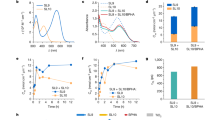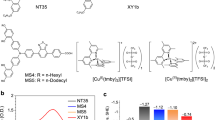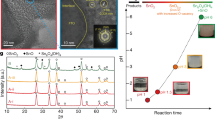Abstract
Dye-sensitized solar cells based on titanium dioxide (TiO2) are promising low-cost alternatives to conventional solid-state photovoltaic devices based on materials such as Si, CdTe and CuIn1−xGa x Se2 (refs 1, 2). Despite offering relatively high conversion efficiencies for solar energy, typical dye-sensitized solar cells suffer from durability problems that result from their use of organic liquid electrolytes containing the iodide/tri-iodide redox couple, which causes serious problems such as electrode corrosion and electrolyte leakage3. Replacements for iodine-based liquid electrolytes have been extensively studied, but the efficiencies of the resulting devices remain low3,4,5,6,7,8,9. Here we show that the solution-processable p-type direct bandgap semiconductor CsSnI3 can be used for hole conduction in lieu of a liquid electrolyte. The resulting solid-state dye-sensitized solar cells consist of CsSnI2.95F0.05 doped with SnF2, nanoporous TiO2 and the dye N719, and show conversion efficiencies of up to 10.2 per cent (8.51 per cent with a mask). With a bandgap of 1.3 electronvolts, CsSnI3 enhances visible light absorption on the red side of the spectrum to outperform the typical dye-sensitized solar cells in this spectral region.
This is a preview of subscription content, access via your institution
Access options
Subscribe to this journal
Receive 51 print issues and online access
$199.00 per year
only $3.90 per issue
Buy this article
- Purchase on Springer Link
- Instant access to full article PDF
Prices may be subject to local taxes which are calculated during checkout





Similar content being viewed by others
References
Hagfeldt, A., Boschloo, G., Sun, L. C., Kloo, L. & Pettersson, H. Dye-sensitized solar cells. Chem. Rev. 110, 6595–6663 (2010)
Grätzel, M. Recent advances in sensitized mesoscopic solar cells. Acc. Chem. Res. 42, 1788–1798 (2009)
Yanagida, S., Yu, Y. H. & Manseki, K. Iodine/iodide-free dye-sensitized solar cells. Acc. Chem. Res. 42, 1827–1838 (2009)
Koh, J. K., Kim, J., Kim, B., Kim, J. H. & Kim, E. Highly efficient, iodine-free dye-sensitized solar cells with solid-state synthesis of conducting polymers. Adv. Mater. 23, 1641–1646 (2011)
Daeneke, T. et al. High-efficiency dye-sensitized solar cells with ferrocene-based electrolytes. Nature Chem. 3, 211–215 (2011)
Wang, M. K. et al. An organic redox electrolyte to rival triiodide/iodide in dye-sensitized solar cells. Nature Chem. 2, 385–389 (2010)
Liu, X. Z. et al. An efficient organic-dye-sensitized solar cell with in situ polymerized poly(3,4-ethylenedioxythiophene) as a hole-transporting material. Adv. Mater. 22, E150–E155 (2010)
Jiang, K. J. et al. Photovoltaics based on hybridization of effective dye-sensitized titanium oxide and hole-conductive polymer P3HT. Adv. Funct. Mater. 19, 2481–2485 (2009)
Bach, U. et al. Solid-state dye-sensitized mesoporous TiO2 solar cells with high photon-to-electron conversion efficiencies. Nature 395, 583–585 (1998)
Bisquert, J. Dilemmas of dye-sensitized solar cells. ChemPhysChem 12, 1633–1636 (2011)
Yella, A. et al. Porphyrin-sensitized solar cells with cobalt (II/III)-based redox electrolyte exceed 12 percent efficiency. Science 334, 629–634 (2011)
Cai, N. et al. An organic D-π-A dye for record efficiency solid-state sensitized heterojunction solar cells. Nano Lett. 11, 1452–1456 (2011)
O'Regan, B., Lenzmann, F., Muis, R. & Wienke, J. A solid-state dye-sensitized solar cell fabricated with pressure-treated P25-TiO2 and CuSCN: analysis of pore filling and IV characteristics. Chem. Mater. 14, 5023–5029 (2002)
Bandara, J. & Weerasinghe, H. Solid-state dye-sensitized solar cell with p-type NiO as a hole collector. Sol. Energy Mater. Sol. Cells 85, 385–390 (2005)
Kroon, J. M. et al. Nanocrystalline dye-sensitized solar cells having maximum performance. Prog. Photovolt. Res. Appl. 15, 1–18 (2007)
Shum, K. et al. Synthesis and characterization of CsSnI3 thin films. Appl. Phys. Lett. 96, 221903 (2010)
Grätzel, M. Photoelectrochemical cells. Nature 414, 338–344 (2001)
Lee, B., Buchholz, D. B., Guo, P. J., Hwang, D. K. & Chang, R. P. H. Optimizing the performance of a plastic dye-sensitized solar cell. J. Phys. Chem. C 115, 9787–9796 (2011)
Lee, B. et al. Materials, interfaces, and photon confinement in dye-sensitized solar cells. J. Phys. Chem. B 114, 14582–14591 (2010)
Kojima, A., Teshima, K., Shirai, Y. & Miyasaka, T. Organometal halide perovskites as visible-light sensitizers for photovoltaic cells. J. Am. Chem. Soc. 131, 6050–6051 (2009)
Acknowledgements
The authors acknowledge support for this collaborative research: NSF-DMR 0843962 for R.P.H.C.; DOE Energy Frontier Research Center, ANSER, DE-SC0001059 for B.H.L., J.H. and M.G.K.; the Initiative for Energy and Sustainability at Northwestern (ISEN) for I.C. Device testing and measurements were done in the ANSER Facilities and materials characterization was performed in the NSFMRSEC Facilities (DMR-1121262).
Author information
Authors and Affiliations
Contributions
I.C. and M.G.K. conceived and designed the experiments and prepared the manuscript. I.C. synthesized materials. R.P.H.C. and B.L. designed and fabricated the solar cells, I.C. and B.L. performed measurements. J.H. collected TEM data. I.C., B.L., R.P.H.C. and M.G.K. discussed the results and wrote the manuscript.
Corresponding author
Ethics declarations
Competing interests
The authors declare no competing financial interests.
Supplementary information
Supplementary Information
This file contains Supplementary Tables 1-3 and Supplementary Figures 1-4. (PDF 352 kb)
Rights and permissions
About this article
Cite this article
Chung, I., Lee, B., He, J. et al. All-solid-state dye-sensitized solar cells with high efficiency. Nature 485, 486–489 (2012). https://doi.org/10.1038/nature11067
Received:
Accepted:
Published:
Issue Date:
DOI: https://doi.org/10.1038/nature11067
This article is cited by
-
Solution-processable mixed-anion cluster chalcohalide Rb6Re6S8I8 in a light-emitting diode
Nature Materials (2024)
-
Effect of silver nanoparticles prepared by green chemistry on the photovoltaic properties of zinc phthalocyanine
Chemical Papers (2024)
-
SnIP-type atomic-scale inorganic double-helix semiconductors: Synthesis, properties, and applications
Nano Research (2024)
-
An Absorber Enrichment Study and Implications on the Performance of Lead-Free CsSnI3 Perovskite Solar Cells (PSCs) Using One-Dimensional Solar Cell Capacitance Simulator (1D-SCAPS)
Brazilian Journal of Physics (2024)
-
Antimony doped CsPbI2Br for high-stability all-inorganic perovskite solar cells
Nano Research (2024)
Comments
By submitting a comment you agree to abide by our Terms and Community Guidelines. If you find something abusive or that does not comply with our terms or guidelines please flag it as inappropriate.



